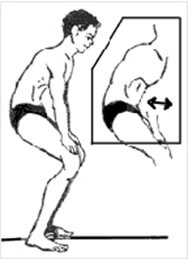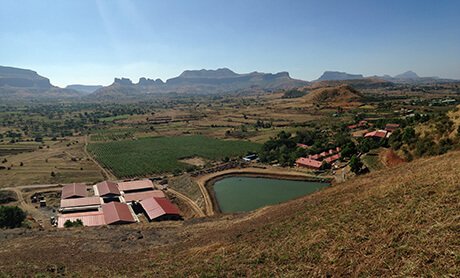This bandha or lock involves the movement of the muscles of the abdomen and especially the diaphragm. Hatha Yoga assigns a special importance to Uddiyan Bandha and the study of pranayama is not complete without studying this lock. While performing this lock the muscles of the diaphragm are pulled in an upward direction; Uddiyan in Sanskrit is moving up hence this bandh is termed as Uddiyan Bandha. This lock is also useful for awakening of Kundalini Shakti which is another reason the name is there, for raising the energy upward.
The lock involves the action of the muscles of the abdomen and hence it may be performed while in a standing pose or sitting pose. The bandha can also be performed in Padmasan, Siddhasan, Vajrasan or any other meditative asana. However for best results, and especially when learning, it is best to perform the lock in a standing position.

Tones the reproductive organs
Regulates the menstrual cycle.
when releasing the bandha one may inhale, raising the arms up over the head and exhaling lowering the arms down. This can be helpful if there is any tension in the neck.
Abdomen being pulled in and up
Manipur chakra, Navel region, external breath retention, relaxation, stillness
Try to relax as much as possible to hold the bandha longer
Have a slight hunch in upper back
Bend neck forward like Jalandhar bandha, but not contracting the throat.
Have any strain
Hold so long that there is tension in the throat, resulting in coughing
The muscles of the diaphragm are well exercised and this movement therefore helps improve breathing.
The organs in the abdomen develop a negative pressure. Due to this pressure, the blood supply to these organs is improved. The difference between the negative pressure during this bandh and the normal pressures resumed after relaxation increases friction on the internal organs such as the stomach, small intestines, liver and pancreas thereby improving their efficiency. This also results in improving the secretion of the digestive juices, improving the digestive function.
It is stated in various ancient texts that apart from these benefits, the bandh is also useful for spiritual progress and awakening of Kundalini power.
It is very important for practice this bandha independently as a preparation for tribandha and pranayama.
Stimulates the digestive fire and appetite is stimulated,
Tones liver, pancreas, adrenals, urinary and excretory systems. Removes impurities and improves the efficiency of all the organs.
Excellent practice for helping depression, also removes fatigue and lethargy.
Stimulates vagus nerve which is stimulation to parasympathetic nervous system and that brings mental, physical relaxation and peace.
Improves blood supply throughout the whole torso
Reverses the flow of apana and prana, causing union with samana and maipur chakra.
Stimulation of manipur chakra, the energy distribution centre, increases pranic energy.
Balances all 5 pranas in the body.
Diabetes
Low appetite
Weight loss
Poor digestion and malabsorption
Flatulence
Depression, stress and anxiety
Reproductive problems
Avoid if there has been any abdominal surgery, high blood pressure, heart disease, ulcers, diarrhoea, menstruation, hernia, intracranial pressure, glaucoma, pregnancy or acidity. Always practice on an empty stomach and if possible, empty bladder and bowels.
3-5 rounds can be practiced, holding for 10 seconds or as long as is comfortable. Slowly the time duration can be increased up to 1 minute.
Sometimes making a false inhalation by trying to expand the chest as if one is breathing in Uddiyan bandha can help improve the bandha as it helps to pull the diaphragm upwards.
Agnisar Dhouti
Tribandha and pranayam
The third chapter in the Hatha Yoga Pradipika describes ten mudras. Uddiyan bandh has been described as one of the mudras. The writer of Hatha Yoga Pradipika explains why this mudra is termed as Uddiyan bandha as follows :
Badhho yen sushumnayam pranastuddiyate yatah |
TasmadUddiyanakhyoyam yogibhihi samudahrutah||3-55
Meaning -
The prana in the body is raised due to the performance of this bandha, hence this bandha is termed as Uddiyan bandha.
The action of this bandh is described below :
Udare paschimam tanam nabherudhwaram cha karayet
Uddiyano hyasou bandho mrityumatang kesari || 3-57
Meaning -
The abdomen is to be pulled (stretched) inwards and the navel upwards. This process is known as Uddiyan bandha. This action is like a lion killing an elephant which represents death. Nowhere in the process is it described that the bandha is to be performed after exhalation. This part was taught as a matter of master–disciple tradition and hence perhaps not explained in detail in the shloka.
The effects of this bandh have been described below:
Uddiyanam tu sahajam gurunam kathitam sada |
Abhyasetsatatam yastu vruddhopi tarunayate || 3-58
Meaning -
If the bandha is practised constantly and regularly as taught by the Guru, even an old man can be reverted into a young one. The effects have been a bit exaggerated however the hidden meaning is to be understood. The bandha causes certain beneficial effects on the body, which in turn result in a youth like state of the body, full of enthusiasm.
The next shloka describes:
Nabherurdhwamadhaschapi tanam kuryatprayatnatah |
Shanmasbhyasenmrutyum jayatyeva na samshayah || 3-59
Meaning -
If a sadhaka practices stretching the navel, the portion below the navel and the upper part of the abdomen towards the back and upward direction regularly for a period of six months, there is no doubt that he can win over death. This description is also a bit exaggerated however the logic behind it must be understood. We should not blindly believe that practising this bandah for six months will win over the death, but we should still practice this bandha regularly so that its beneficial effects on the body will result in increasing our life span. A shloka after this describes that the study of this bandha results in leading the sadhaka easily onto the path of mukti (liberation).
| COURSE | Venue |
Phone - +91-9822770727
E-mail - yoga@yogapoint.com or yogapoint108@gmail.com

Yoga Vidya Dham, Kaivalya Nagari,
College Road, Nashik - 422005.
Maharashtra, India.
Phone - +91-9822770727 (for courses in ENGLISH)
+91-253-2318090 (For courses, in HINDI or MARATHI)
(Please call during 9.00 AM to 5 PM Indian Time)
E-mail - yoga@yogapoint.co or yogapoint108@gmail.com
Village Talwade, Trimbak, Nasik
Maharashtra,India.
Phone - +91-9822770727
E-mail - yoga@yogapoint.com or yogapoint108@gmail.com